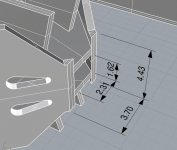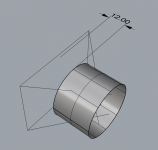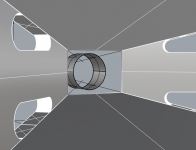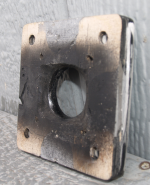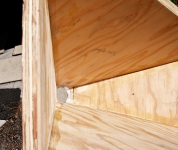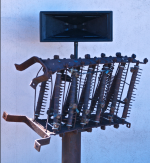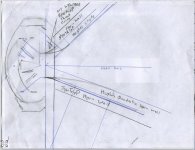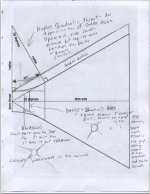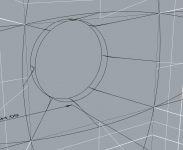Hey FinBot! I live with a drafter. If you send me a cad file, he'd be happy to spit out plans. I am super interested in building the most recent version. Happy to help in any way!
Oh just found it earlier in the thread: https://drive.google.com/file/d/0BwGf5Kb0D758Skl4Sk02a2Zaenc/view
That's the most recent?
That's the most recent?
Okay sorry for so many questions, I am downloading this all to my brain after about 18 months of hiatus and my head is spinning. This is incredible work!!
I'd love to model the throat adapter and plug, with the end result printing it out on the gigabot for another SynTripP build.
I imported FinBot's model I linked to above into Rhino, pretty sure it's a good one to work from?
Si? Hughes style?
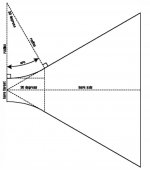
Edit: Guess what I need to know is the radius, sorry if it's been noted elsewhere. Probably is 😀
I'd love to model the throat adapter and plug, with the end result printing it out on the gigabot for another SynTripP build.
I imported FinBot's model I linked to above into Rhino, pretty sure it's a good one to work from?
Si? Hughes style?

Edit: Guess what I need to know is the radius, sorry if it's been noted elsewhere. Probably is 😀
Last edited:
I think the radius for the purposes of making a smooth transition from a round throat is probably not a hard and fast rule. If the drawing above is to scale, that radius looks just a bit bigger than the half-width of the horn. If you were making a round oblate spheroid (OS) profile then that radius is more critical and you would have to read up on the theory where that is described (many other threads discuss this - search OS waveguide).
Jenny,Si? Hughes style?
View attachment 547464
Edit: Guess what I need to know is the radius, sorry if it's been noted elsewhere. Probably is 😀
The throat radius is shown in post #41, it is not the Hughes style, which would result in more depth and high frequency narrowing.
Art
Brian,Hi Art, did you ever get the passive crossover part done?
I have not found a need to use a passive crossover, so spending hours designing, testing and building them has just not been high on the priority list.
Having heard FIR filter implementation with flat phase, vs. smooth but wrapped phase over headphones, and finding I can't hear the difference, have not pursued that either. Age and noise related hearing loss sucks...
Art
Art, I'm about at the conclusion that hearing phase is about 2 things:
1. no sudden changes.... why lots of eq and steep filters don't work
2. the sonic benefits to flat phase are probably more about eliminating amplitude ripple in systems though their crossover regions, than anything else.
I think #2 is maybe why headphones don't make such a good test case for flat phase..no multiway drivers out of phase with each other...
1. no sudden changes.... why lots of eq and steep filters don't work
2. the sonic benefits to flat phase are probably more about eliminating amplitude ripple in systems though their crossover regions, than anything else.
I think #2 is maybe why headphones don't make such a good test case for flat phase..no multiway drivers out of phase with each other...
I must be seeing this incorrectly, it looks impossible to transition the flare from rectangular to circular over a 12mm depth. Otherwise the crease lines overshoot the circular opening
Switching to metric units
Switching to metric units
Attachments
Last edited:
The transition continues from the adapter plate into the horn throat. It is easy to accomplish with files and sandpaper around a dowel.I must be seeing this incorrectly, it looks impossible to transition the flare from rectangular to circular over a 12mm depth. Otherwise the crease lines overshoot the circular opening
Attachments
The transition continues from the adapter plate into the horn throat. It is easy to accomplish with files and sandpaper around a dowel.
Ohhh okay, that makes sense. Thanks Art!
Okay, still not making sense. I've been going through your measurements in post 41 and comparing with the model to make sure I am all lined up.
It still doesn't make sense that the adapter is only 12mm. It has to be thicker? There is not enough room to blend
It still doesn't make sense that the adapter is only 12mm. It has to be thicker? There is not enough room to blend
Brian,
I have not found a need to use a passive crossover, so spending hours designing, testing and building them has just not been high on the priority list.
LOL, no worries. I was just wondering it was possible to drive one of these things successfully without the use of active filtering / EQ to achieve a flat (or flattish) response on axis. I'm thinking ahead to "Blastoramas V3", and I want to stick to the simple and basic plug'n'play config of the original Blastoramas.
Age and noise related hearing loss sucks...
Yup. Just discovered yesterday that nothing above 15kHz exists as far as my hearing is concerned, except for the ~16kHz tinnitus in my right ear of course. Thankfully it comes and goes (though it seems to have stayed a bit longer than usual this time around!).
With no filtering at all the combined response of the 10" and HF driver is "flattish", so passive filters could "get er done".
My tinnitus persists constantly at about the equivalent of 60 dB at 4kHz, where I have about a 60dB noise induced hearing loss. Nothing really sounds "great" any more, some things just sound worse 😉 .
My tinnitus persists constantly at about the equivalent of 60 dB at 4kHz, where I have about a 60dB noise induced hearing loss. Nothing really sounds "great" any more, some things just sound worse 😉 .
Art- I dug back into the Tripp 10 thread, post 143. Close to where we last left off so many months ago. Me = 
I was under the impression that the creases of the edge of the throat had to blend straight and transition smoothly into tubular profile. But, it appears to flatten out a little bit? Hard to tell from the photo
Is that a 12mm ply with 1/4" aluminum, for close to 3/4 thickness total?
EDIT: further clarification on my question... It appears to blend just fine at the top and bottom of the port adapter, but the sides appear to be somewhat flat to the edge of the horn wall

I was under the impression that the creases of the edge of the throat had to blend straight and transition smoothly into tubular profile. But, it appears to flatten out a little bit? Hard to tell from the photo
Is that a 12mm ply with 1/4" aluminum, for close to 3/4 thickness total?
EDIT: further clarification on my question... It appears to blend just fine at the top and bottom of the port adapter, but the sides appear to be somewhat flat to the edge of the horn wall
Attachments
No it has been redone in Solidworks.Oh just found it earlier in the thread: SynTripP Sketchup.skp - Google Drive
That's the most recent?
I have not linked them here as I don't want to put multiple incomplete versions of it through the thread. PM me and Ill send you the link.
They do still need a few things tweaked:
1 - The secondary horns are 2/3 size. We should probably do them 1:1: scale.
2 - The throat adaptor was not included/finished. We used the Ferrite version of the compression driver (heavy, not recommended!) and made an adaptor plate up on the fly.
3 - Handles and pole mount not included.
We used fixed pole mounts and are yet to fit handles.
There are some plastic adjustable pole mounts available that are easy to install:
Eminence Top Hat-CH Adjustable Speaker Pole Mount
Last edited:
Hi Fin! So excited to see your most recent model and/or plans. I am gearing up for a build of two SynTripPs starting tomorrow 🙂
I had quite an interesting experience last night just outside of Joshua Tree at Pappy & Harriets bar in Pioneertown. I saw Ben UFO, Andy Stott, and Four Tet perform, and the outdoor live sound setup was strikingly devoid of midrange. At first, I was unsure if it was just me... but the confused look on several people's faces in the audience convinced me to ask others.. Turns out that it was not just me wandering around the dance floor searching for full frequencies. Several others had similar experience, wandering around a bit lost, stressed. It induced some initial anxiety to know that I would have to extrapolate the frequencies myself in order to "tune in" to the music being played, which was indeed beautiful. It was almost hidden, though, and rather difficult at times. Luckily in the end, I ended up having a wonderful time regardless. It was a learning experience for me. Excellent 🙂
I came back to Los Angeles today more charged than ever to build two of these speakers.
I did send you a PM with my email, and totally understand the desire to keep things concise on the forums- not publicly sharing incomplete versions. Happy to help!
I had quite an interesting experience last night just outside of Joshua Tree at Pappy & Harriets bar in Pioneertown. I saw Ben UFO, Andy Stott, and Four Tet perform, and the outdoor live sound setup was strikingly devoid of midrange. At first, I was unsure if it was just me... but the confused look on several people's faces in the audience convinced me to ask others.. Turns out that it was not just me wandering around the dance floor searching for full frequencies. Several others had similar experience, wandering around a bit lost, stressed. It induced some initial anxiety to know that I would have to extrapolate the frequencies myself in order to "tune in" to the music being played, which was indeed beautiful. It was almost hidden, though, and rather difficult at times. Luckily in the end, I ended up having a wonderful time regardless. It was a learning experience for me. Excellent 🙂
I came back to Los Angeles today more charged than ever to build two of these speakers.
I did send you a PM with my email, and totally understand the desire to keep things concise on the forums- not publicly sharing incomplete versions. Happy to help!
Art- I dug back into the Tripp 10 thread, post 143. Close to where we last left off so many months ago. Me =
I was under the impression that the creases of the edge of the throat had to blend straight and transition smoothly into tubular profile. But, it appears to flatten out a little bit? Hard to tell from the photo
Is that a 12mm ply with 1/4" aluminum, for close to 3/4 thickness total?
EDIT: further clarification on my question... It appears to blend just fine at the top and bottom of the port adapter, but the sides appear to be somewhat flat to the edge of the horn wall
I got some images of what we did.
I used ONE plate made from 12mm ply, and used a dremel to make a trasition in an oval shape to get close-ish to the horn transition. Then used some wood filler and sandpaper to finish off in the horn cornerns and make it smoothe.
I think art used TWO adaptor plates at 12 mm together to make a longer transition (based on the drawings). I used the ferrite CD which has a longer throat than the neo version.
We just made it up as we went, but I have images I can post.
- Home
- Loudspeakers
- Multi-Way
- SynTripP: 2-way 2-part Virtual Single Point Source Horn
